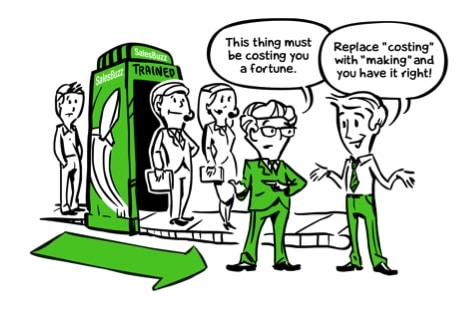The 5-Step Cold Call Anxiety Solution

“How Do You Deal with Anxiety Before Each Cold Call?”
Cold call anxiety happens when at least one of these two things is present:
- Lack of confidence
- Fear of rejection
You can psych yourself up all you want to make cold calls. Still, if you are continually being rejected when selling by phone, eventually, no matter what you tell yourself or do to get all jazzed up before making the dials, the rejections will continue if you don’t fix the real problem.
Ultimately, selling won’t be enjoyable anymore.
And when selling isn’t fun, you’re in real trouble. Like, “Can’t make the mortgage payment because I haven’t hit quota in 3-months” trouble.
Here are 5-Steps to Eliminate Call Anxiety:
- Know your ICP (Ideal Customer Profile)
- Build your targeted list
- Create a winning opening value statement
- Know the first three sales questions you need to ask
- Role-play
#1: Know Your ICP
I’ve discussed how to identify your ICP before. It’s so important for salespeople to understand who their target market is – there are key indicators and “markers” that identify prospects who have a higher % of buying what you offer.
Yes, there will always be those one off’s that don’t match your profile but call in and buy – let those happen on warm inbound leads. When it comes to outbound prospecting, go after the prospects that are the best fit. Otherwise, you’ll burn yourself out quickly.
#2: Build Your Targeted List
Once you know who your target audience is, build your prospect list. Start with having at least 200 leads that match your ICP.
There’s an average of 21 business days per month. If you have a new list of 200 leads to start and strive to hit 60-dials per day, you will average 6.3 attempts (calls) within 30-days to reach your entire list.
(21 days x 60 dials per day = 1,260 dials divided 200 leads = 6.3 attempts per lead per month)
As you progress through the list, the number will shrink as some prospects will buy, some will say no, some will go in the pipeline and others will not respond.
As the list degrades, set a block time to prospect to replace the leads that have made a decision (yes, no, or soon) or ones you no longer wish to chase.
The only bad thing about closing a deal is you just lost your best prospect. So continued prospecting is critical, and you do not want to be unorganized about it. You want to be intentional.
Most salespeople make the mistake of “prospecting” during calling hours. Don’t be most salespeople, or you will be “average” and will earn accordingly.
#3: Create a Winning Opening Value Statement
I’ve written extensively about Opening Value Statements. You can even get a sneak peek into our “on-demand sales course” on how to create a winning opening value statement.
Your OVS is what you say after “Hello, my name is…” and is where 99% of salespeople go wrong.
Think of sales like baseball. When you pick up the phone, you’re in the batter’s box, and you have to get on first base. Even if you hit a double, you still have to go to first base, then second. You can’t just run from home plate, over the pitcher’s mound, and right to second base.
There are multiple ways to get to first base. You can bunt, hit a single, get walked, get hit by a pitch, etc. So no matter what works best for you, the goal is to get to first base.
In sales, first base is piquing the prospect’s interest in the first few seconds of a call and have them willing to be asked a few questions.
Contrary to popular belief, the objective is NOT to take control of the prospect. That is old, outdated sales thinking. You will close more deals by engaging prospects in a conversation than you will from trying to control them.
It all starts with knowing how to get to first base. The formula is simple:
Know Your ICP > Build Your Targeted List > Create a Winning Opening Value Statement that Piques Interest.
#4) Know Your First Three Sales Questions
Have you ever called a prospect who was willing to take your call and immediately heard their tone/interest level drop within seconds as you struggle to ask questions?
To avoid this scenario, you need to know what the first three sales questions are that you need to ask your prospects after the opening value statement.
The questions should be designed to focus your prospect’s attention in an area you want them to think about as you discover if a problem exists that you can potentially help solve.
Don’t be a “captain-wing it.” Create a playbook of each step of the sales process that gets you from the batter’s box to first base etc.
Your OVS gets you to first base. Your sales questions get you to second base.
#5) Role-play
I know the only thing salespeople hate more than cold-calling is to role-play in front of their peers, but I have two things to say to you:
Iron Sharpens Iron
And:
Amateurs practice till they get it right. Professionals practice until they can’t get it wrong.
The power to determine the level of your skill and earning potential is in your hands.
You just need direction, desire, and commitment to make it happen.
Role-playing a few minutes each morning to sharpen your sales techniques goes a long way to eliminating cold-call anxiety.
Attack it with the 5-step plan outlined above and watch that anxiety disappear.
– Michael Pedone
Founder of SalesBuzz.com. Online Sales Training Programs that Engage.
Turn Your Outside Team Into Inside Sales Stars!
Affordable On-demand Inside Sales Classes
- Curriculum designed for selling by phone
- Group Analyst Roles to Monitor Remote Rep Progress
- Customizable Script Templates
- Unlimited Access for 12-months
- Incredible Results – Highly Recommended
- Dedicated Training Coordinator
Interested? Get a free quote!


